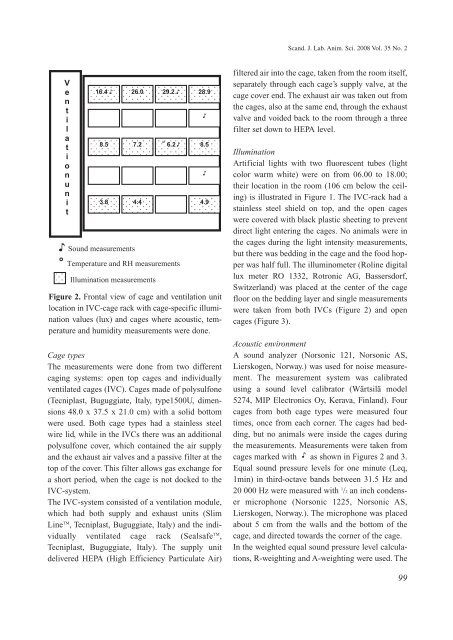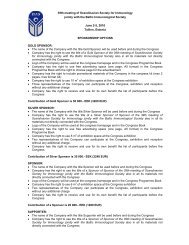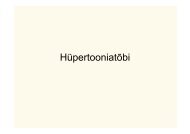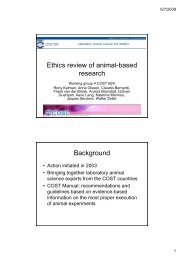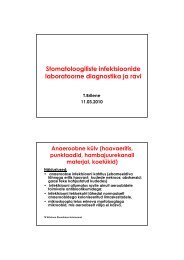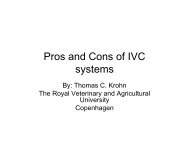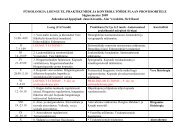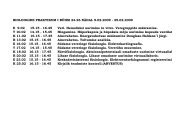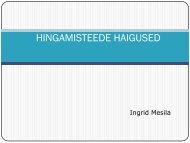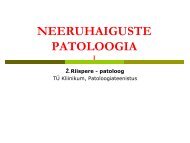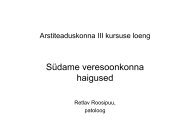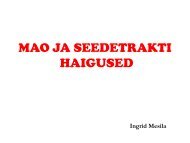Exposure in the Shoebox
Exposure in the Shoebox
Exposure in the Shoebox
You also want an ePaper? Increase the reach of your titles
YUMPU automatically turns print PDFs into web optimized ePapers that Google loves.
V<br />
e<br />
n<br />
t<br />
i<br />
l<br />
a<br />
t<br />
i<br />
o<br />
n<br />
u<br />
n<br />
i<br />
t<br />
16.4 26.0 29.2 28.9<br />
8.5 7.2 ° 6.2 8.5<br />
3.8 4.4 4.9<br />
Sound measurements<br />
° Temperature and RH measurements<br />
Illum<strong>in</strong>ation measurements<br />
Figure 2. Frontal view of cage and ventilation unit<br />
location <strong>in</strong> IVC-cage rack with cage-specific illum<strong>in</strong>ation<br />
values (lux) and cages where acoustic, temperature<br />
and humidity measurements were done.<br />
Cage types<br />
The measurements were done from two different<br />
cag<strong>in</strong>g systems: open top cages and <strong>in</strong>dividually<br />
ventilated cages (IVC). Cages made of polysulfone<br />
(Tecniplast, Buguggiate, Italy, type1500U, dimensions<br />
48.0 x 37.5 x 21.0 cm) with a solid bottom<br />
were used. Both cage types had a sta<strong>in</strong>less steel<br />
wire lid, while <strong>in</strong> <strong>the</strong> IVCs <strong>the</strong>re was an additional<br />
polysulfone cover, which conta<strong>in</strong>ed <strong>the</strong> air supply<br />
and <strong>the</strong> exhaust air valves and a passive filter at <strong>the</strong><br />
top of <strong>the</strong> cover. This filter allows gas exchange for<br />
a short period, when <strong>the</strong> cage is not docked to <strong>the</strong><br />
IVC-system.<br />
The IVC-system consisted of a ventilation module,<br />
which had both supply and exhaust units (Slim<br />
L<strong>in</strong>e TM , Tecniplast, Buguggiate, Italy) and <strong>the</strong> <strong>in</strong>dividually<br />
ventilated cage rack (Sealsafe TM ,<br />
Tecniplast, Buguggiate, Italy). The supply unit<br />
delivered HEPA (High Efficiency Particulate Air)<br />
Scand. J. Lab. Anim. Sci. 2008 Vol. 35 No. 2<br />
filtered air <strong>in</strong>to <strong>the</strong> cage, taken from <strong>the</strong> room itself,<br />
separately through each cage’s supply valve, at <strong>the</strong><br />
cage cover end. The exhaust air was taken out from<br />
<strong>the</strong> cages, also at <strong>the</strong> same end, through <strong>the</strong> exhaust<br />
valve and voided back to <strong>the</strong> room through a three<br />
filter set down to HEPA level.<br />
Illum<strong>in</strong>ation<br />
Artificial lights with two fluorescent tubes (light<br />
color warm white) were on from 06.00 to 18.00;<br />
<strong>the</strong>ir location <strong>in</strong> <strong>the</strong> room (106 cm below <strong>the</strong> ceil<strong>in</strong>g)<br />
is illustrated <strong>in</strong> Figure 1. The IVC-rack had a<br />
sta<strong>in</strong>less steel shield on top, and <strong>the</strong> open cages<br />
were covered with black plastic sheet<strong>in</strong>g to prevent<br />
direct light enter<strong>in</strong>g <strong>the</strong> cages. No animals were <strong>in</strong><br />
<strong>the</strong> cages dur<strong>in</strong>g <strong>the</strong> light <strong>in</strong>tensity measurements,<br />
but <strong>the</strong>re was bedd<strong>in</strong>g <strong>in</strong> <strong>the</strong> cage and <strong>the</strong> food hopper<br />
was half full. The illum<strong>in</strong>ometer (Rol<strong>in</strong>e digital<br />
lux meter RO 1332, Rotronic AG, Bassersdorf,<br />
Switzerland) was placed at <strong>the</strong> center of <strong>the</strong> cage<br />
floor on <strong>the</strong> bedd<strong>in</strong>g layer and s<strong>in</strong>gle measurements<br />
were taken from both IVCs (Figure 2) and open<br />
cages (Figure 3).<br />
Acoustic environment<br />
A sound analyzer (Norsonic 121, Norsonic AS,<br />
Lierskogen, Norway.) was used for noise measurement.<br />
The measurement system was calibrated<br />
us<strong>in</strong>g a sound level calibrator (Wärtsilä model<br />
5274, MIP Electronics Oy, Kerava, F<strong>in</strong>land). Four<br />
cages from both cage types were measured four<br />
times, once from each corner. The cages had bedd<strong>in</strong>g,<br />
but no animals were <strong>in</strong>side <strong>the</strong> cages dur<strong>in</strong>g<br />
<strong>the</strong> measurements. Measurements were taken from<br />
cages marked with as shown <strong>in</strong> Figures 2 and 3.<br />
Equal sound pressure levels for one m<strong>in</strong>ute (Leq,<br />
1m<strong>in</strong>) <strong>in</strong> third-octave bands between 31.5 Hz and<br />
20 000 Hz were measured with 1 /2 an <strong>in</strong>ch condenser<br />
microphone (Norsonic 1225, Norsonic AS,<br />
Lierskogen, Norway.). The microphone was placed<br />
about 5 cm from <strong>the</strong> walls and <strong>the</strong> bottom of <strong>the</strong><br />
cage, and directed towards <strong>the</strong> corner of <strong>the</strong> cage.<br />
In <strong>the</strong> weighted equal sound pressure level calculations,<br />
R-weight<strong>in</strong>g and A-weight<strong>in</strong>g were used. The<br />
99


